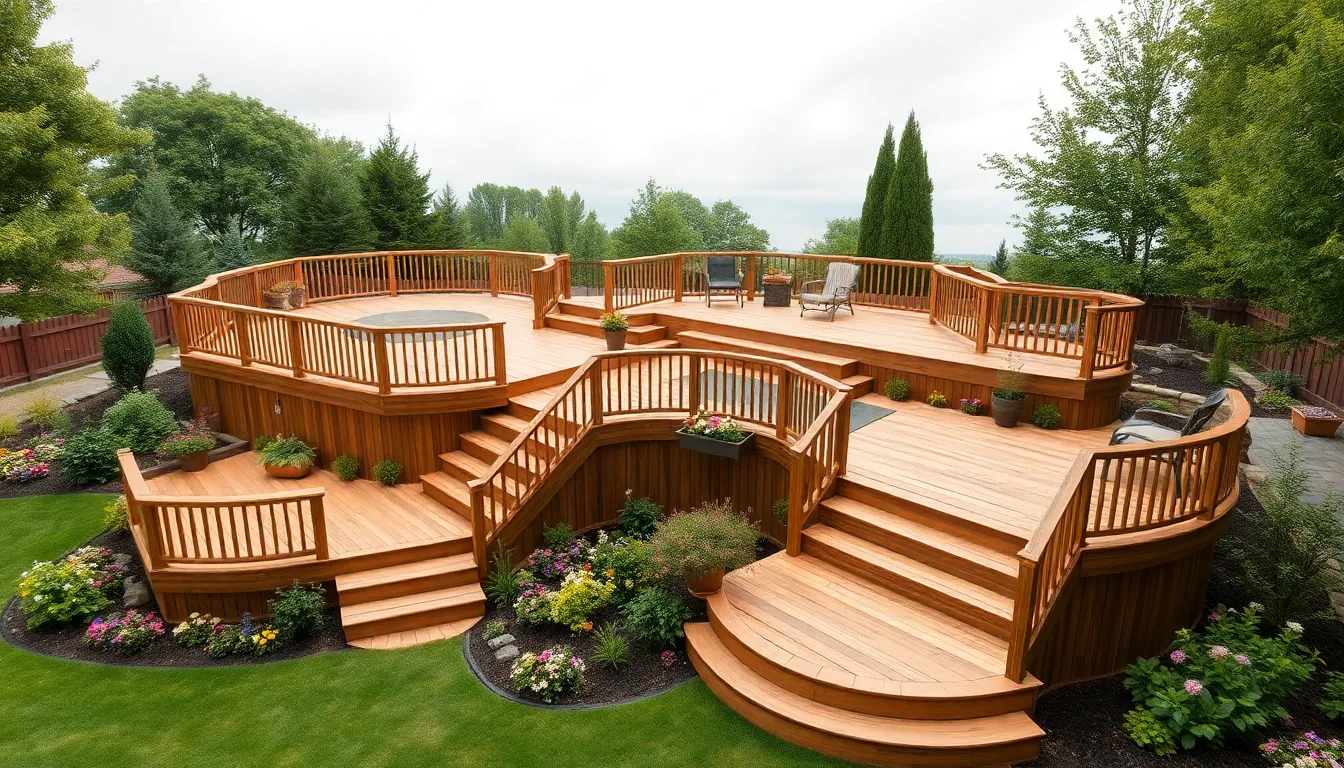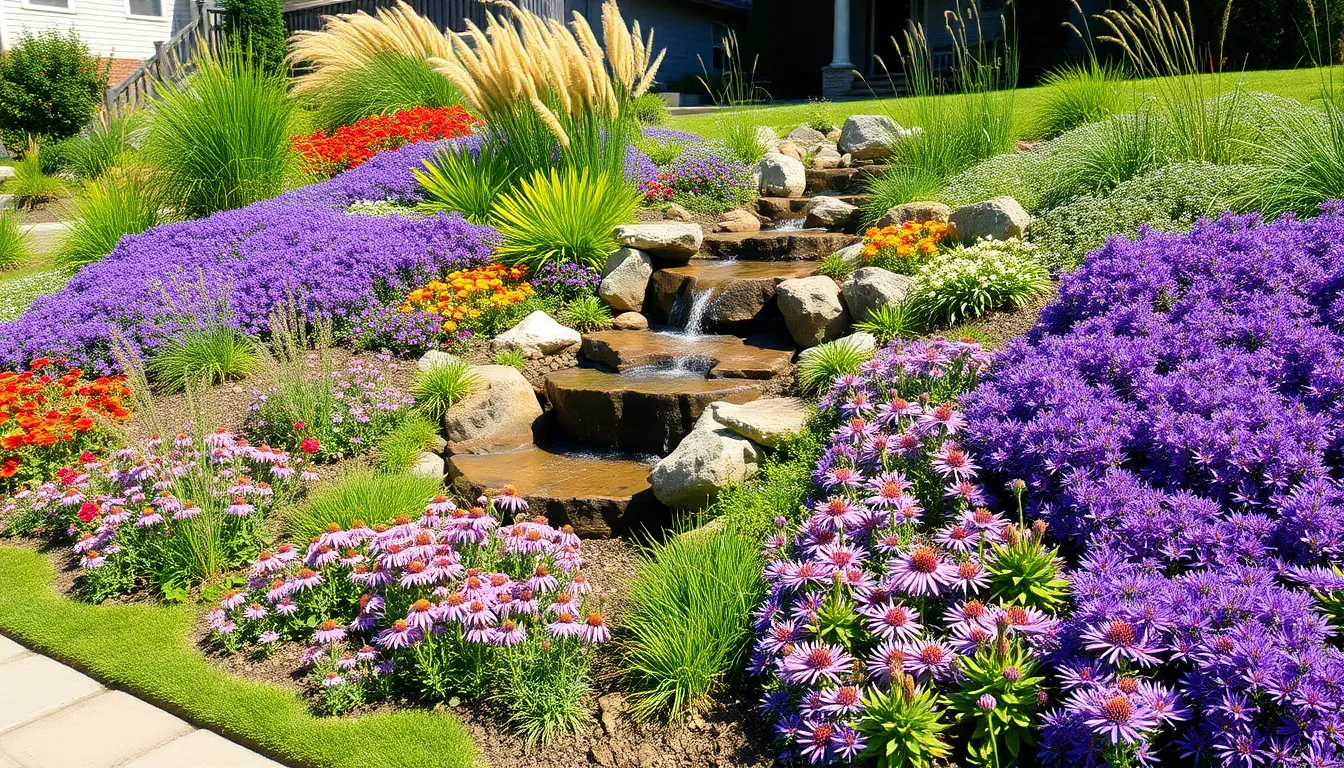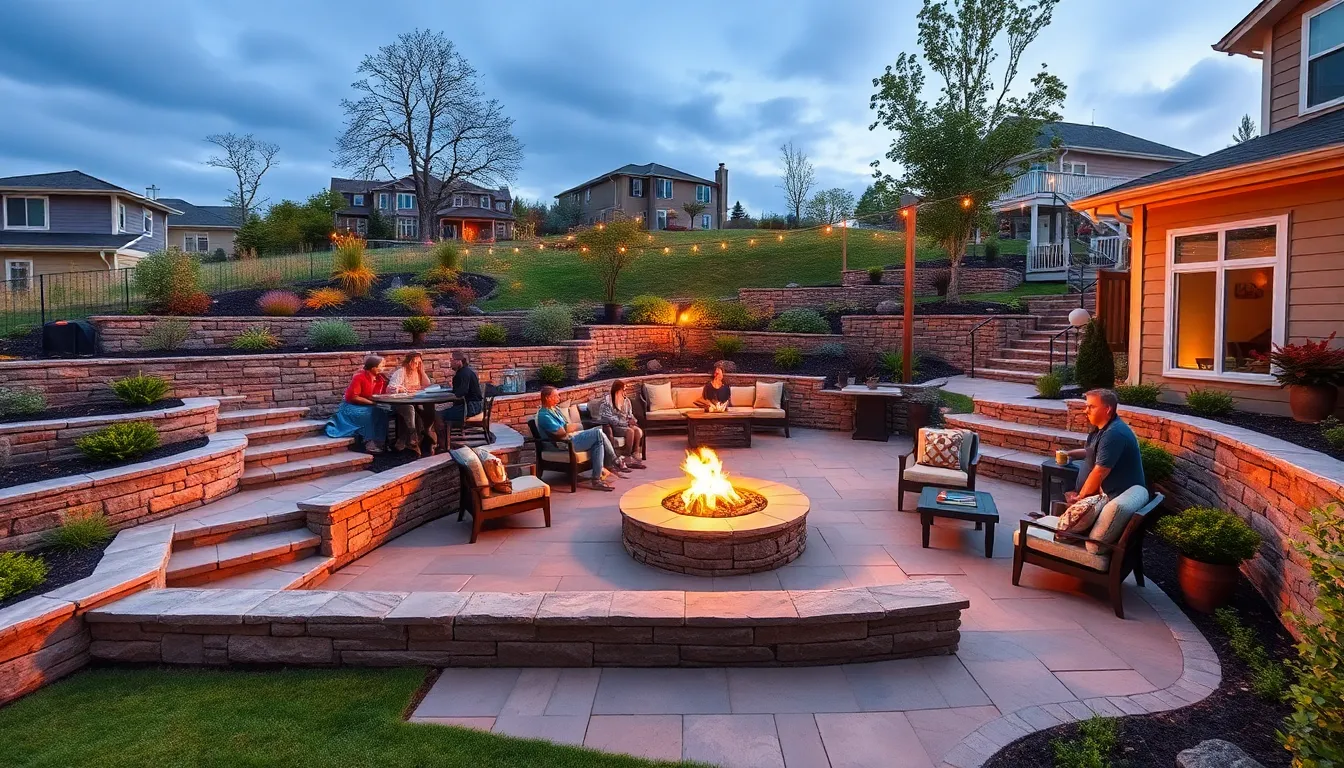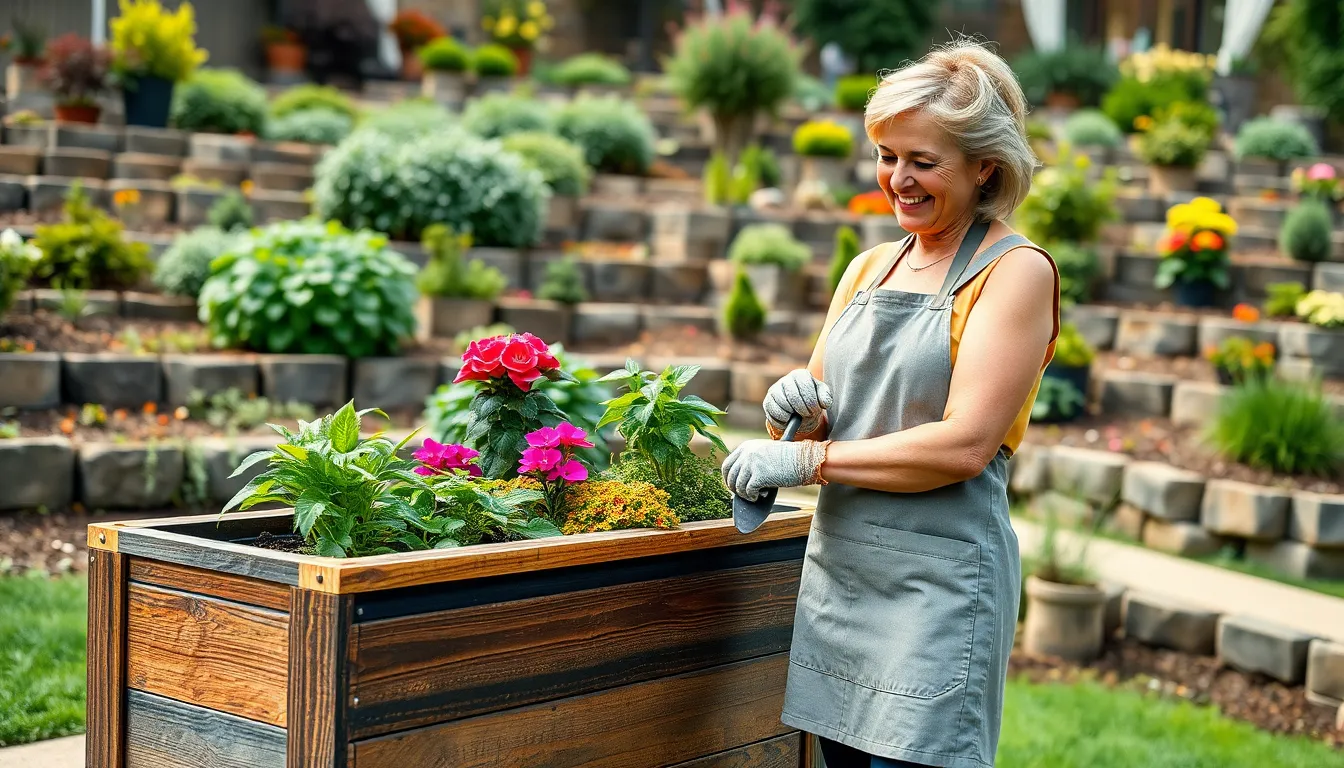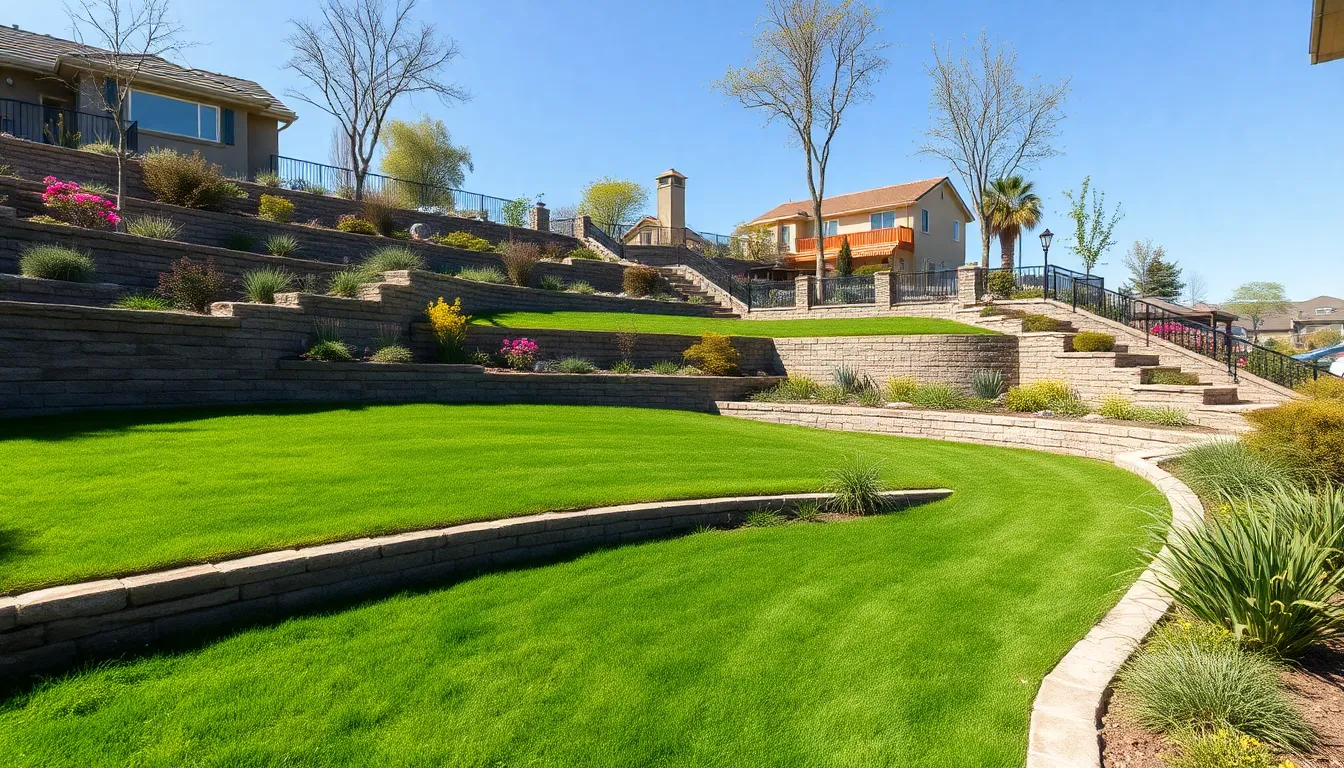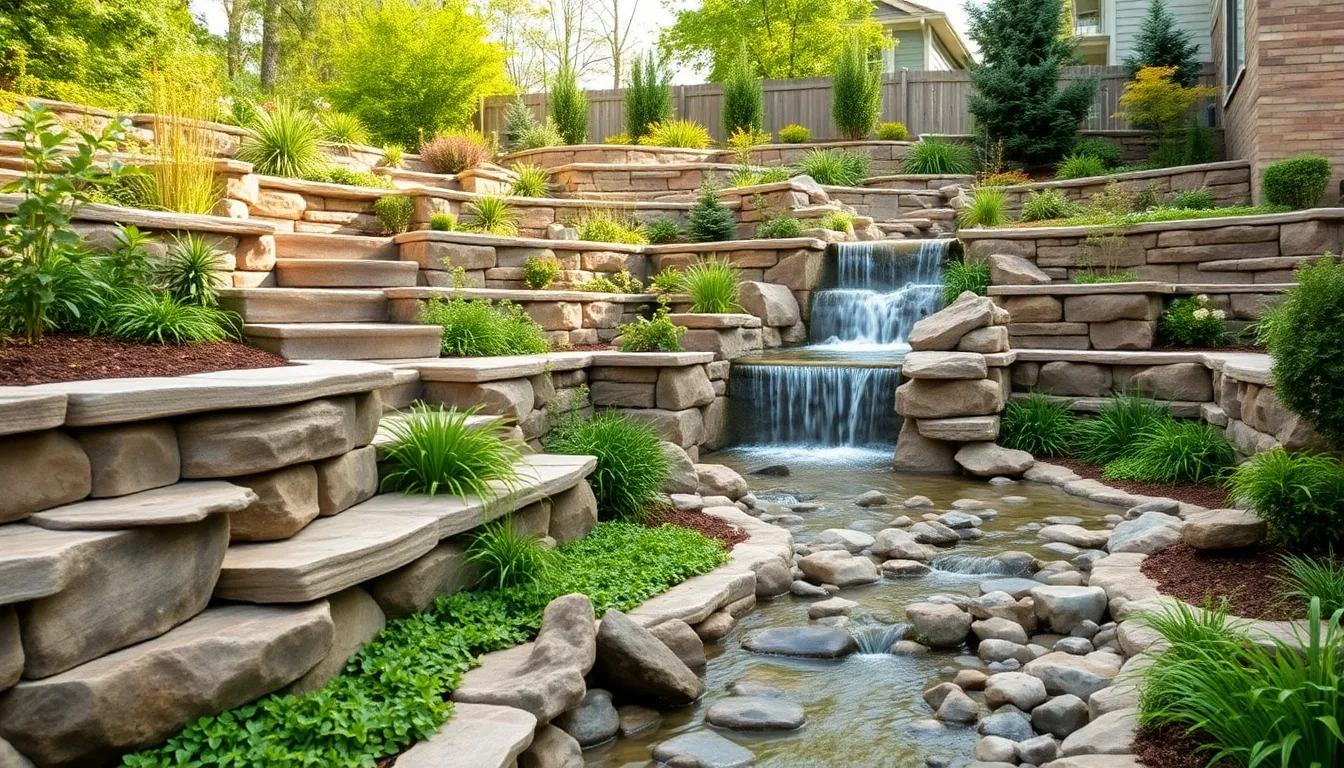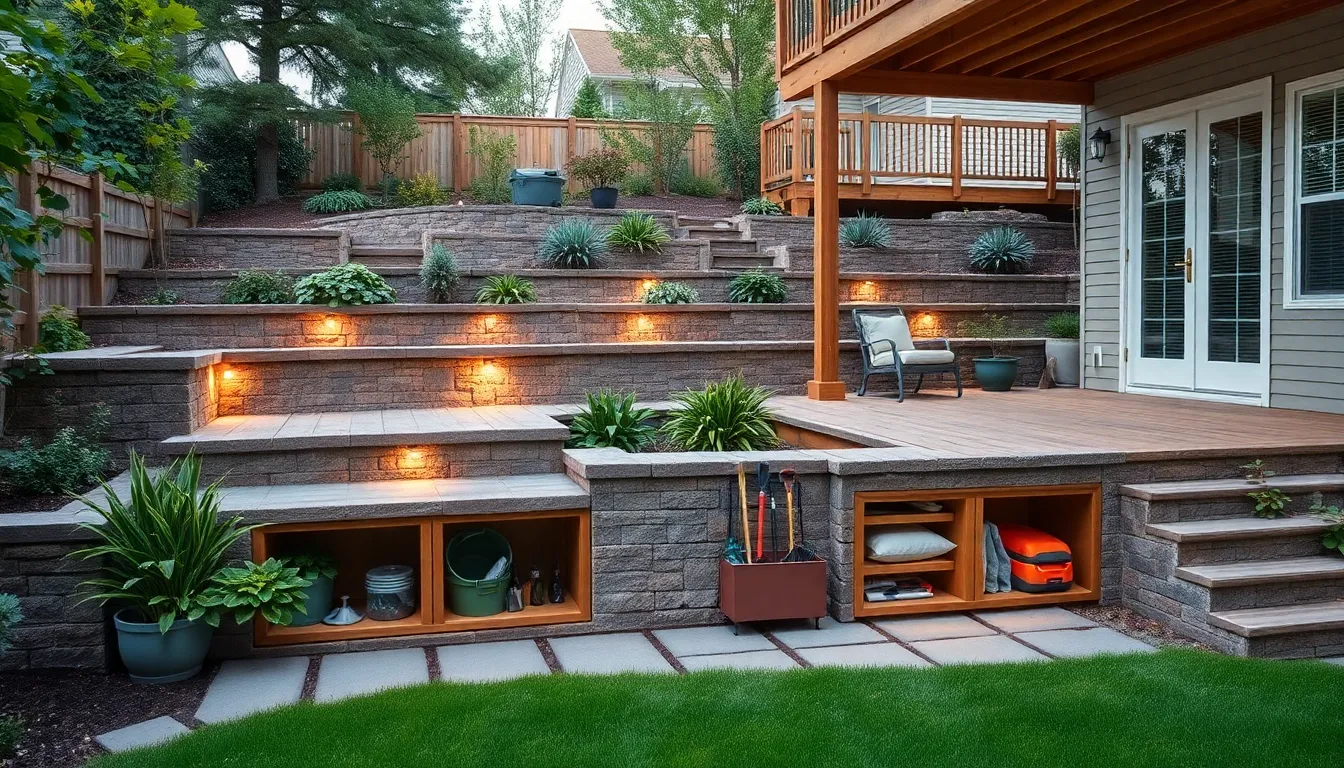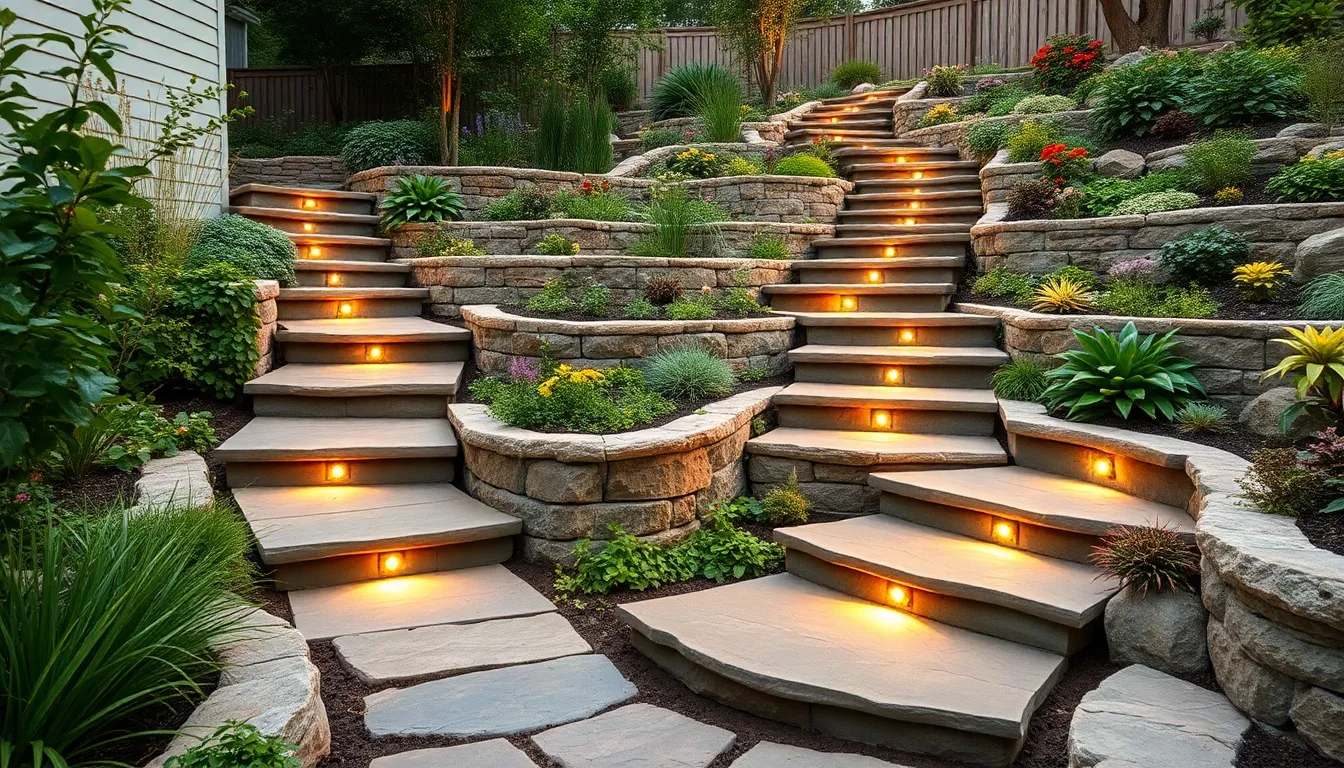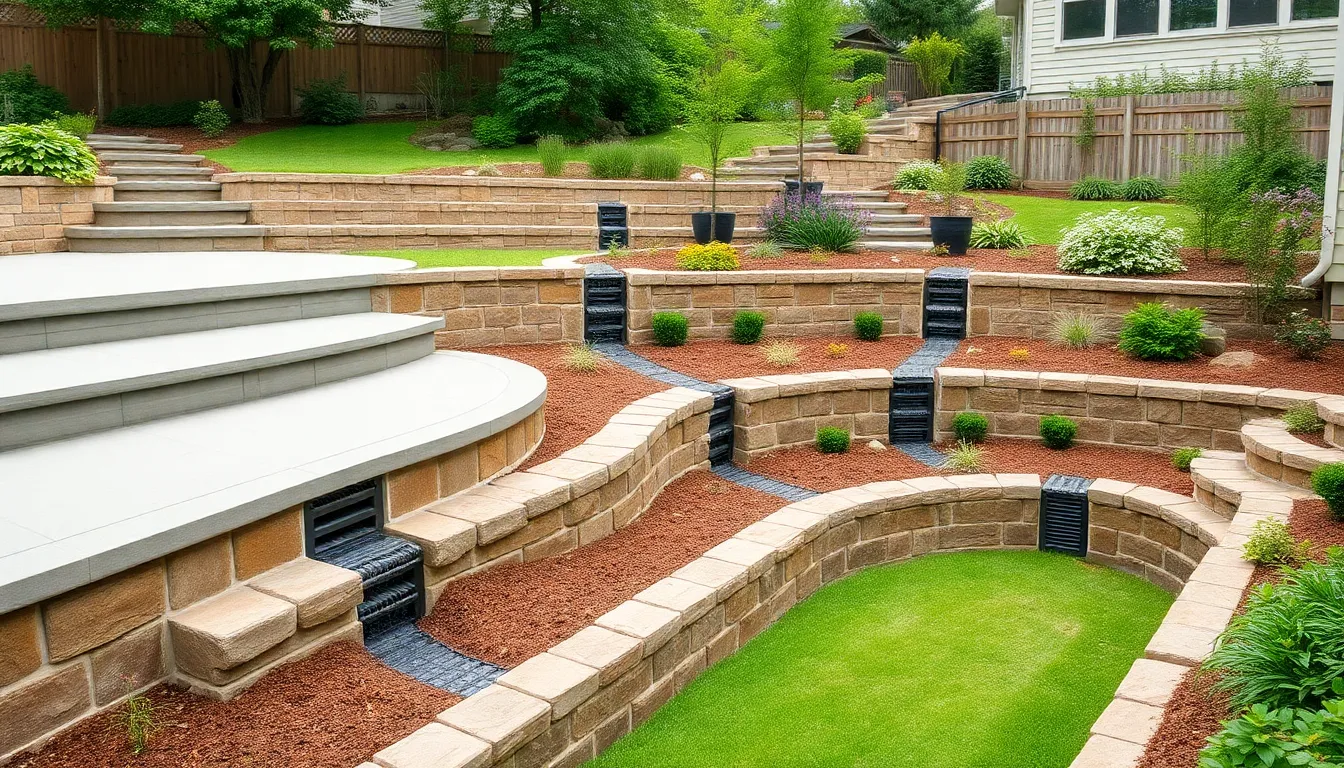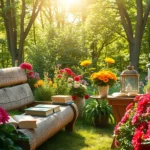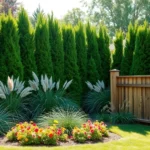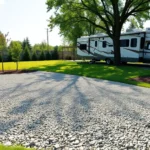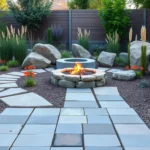A sloped backyard doesn’t have to be a landscaping nightmare. We’ve all seen those challenging hillside spaces that seem impossible to use effectively, but we’re here to change that perspective completely. Tiered landscaping transforms steep slopes into stunning multi-level outdoor sanctuaries that maximize both beauty and functionality.
We’ve discovered that terraced yards offer incredible opportunities for creative design and practical living spaces. From retaining walls that prevent erosion to cascading garden beds that showcase your favorite plants, tiered designs turn problematic slopes into your property’s crown jewel.
Whether you’re dealing with a gentle incline or a dramatic hillside, we’ll show you how strategic terracing creates usable outdoor rooms for entertaining, gardening, and relaxation. These sloped yard answers don’t just solve drainage issues – they add important value to your home while creating the backyard oasis you’ve always wanted.
Create Retaining Wall Terraces for Maximum Stability
Retaining walls serve as the backbone of successful tiered backyard transformations. These structural elements prevent soil erosion while creating stable platforms for our outdoor living spaces.
Choose Natural Stone for Durability
Natural stone materials offer unmatched longevity for retaining wall construction in sloped yards. We recommend flagstone, limestone, and granite as top choices because they withstand weather extremes and ground movement without cracking or deteriorating.
Fieldstone creates rustic charm while providing excellent structural integrity for walls up to 4 feet tall. Local quarry stone typically costs 30-50% less than imported varieties and blends seamlessly with existing industry features.
Mortared stone walls require professional installation but can support terraces up to 8 feet in height. Dry stack methods work perfectly for shorter walls between 2-4 feet and allow for better drainage through natural gaps between stones.
We suggest using larger capstones on top of retaining walls to create natural seating areas and prevent water infiltration. These finishing touches transform functional structures into attractive focal points for our tiered outdoor spaces.
Install Proper Drainage Behind Walls
Drainage systems behind retaining walls prevent hydrostatic pressure that causes structural failure over time. We install French drains with 4-inch perforated pipes surrounded by gravel to redirect water away from wall foundations.
Industry fabric separates drain rock from soil to prevent clogging while allowing water to flow freely. This barrier system maintains drainage efficiency for decades without requiring maintenance or replacement.
Weep holes spaced every 6-8 feet along the wall base provide additional water release points during heavy rainfall. These openings should measure 3 inches in diameter and connect directly to the drainage system behind the wall.
Backfill materials consisting of angular gravel create stable support while promoting water movement toward drainage outlets. We avoid using clay soils or fine materials that retain moisture and create pressure against retaining wall structures.
Build Wooden Deck Platforms at Different Levels
Creating multiple wooden deck platforms at varying heights transforms your sloped backyard into distinct functional zones. These elevated platforms break up the challenging terrain into manageable, usable spaces perfect for outdoor dining, entertaining, and relaxation.
Use Pressure-Treated Lumber for Longevity
Pressure-treated lumber stands as our top recommendation for tiered deck construction due to its superior resistance to moisture, insects, and decay. Weather elements constantly challenge outdoor structures, making this material choice essential for maintaining structural integrity across different elevations. Durability becomes paramount when building multiple levels, as replacement costs multiply with each platform requiring maintenance.
Longevity benefits extend beyond simple weather resistance with pressure-treated lumber requiring significantly less upkeep compared to untreated alternatives. Moisture protection prevents warping and splitting that commonly affects standard wood materials in outdoor environments. Safety remains uncompromised across all deck levels, ensuring your tiered backyard maintains its functionality for years without costly repairs or replacements.
Connect Levels with Built-In Stairs
Built-in stairs provide essential transitions between your tiered deck platforms while maintaining smooth and safe access throughout the elevated spaces. Constructing these stairs from matching pressure-treated lumber creates cohesive aesthetics that tie your entire tiered design together seamlessly. Flow between different backyard zones improves dramatically when stairs integrate naturally into the overall structure.
Design flexibility allows for creative combinations using stone, gravel, or pavers alongside your wooden stair construction for added visual interest. Natural dividers emerge as these stairs separate different functional areas of your tiered layout, improving both practical navigation and aesthetic appeal. Access becomes effortless when built-in stairs eliminate the need for temporary or portable answers that disrupt your backyard’s polished appearance.
Design Cascading Garden Beds for Visual Appeal
Now that we’ve established the structural foundation with retaining walls, we can focus on creating stunning cascading garden beds that transform your slope into a visual masterpiece. These tiered plantings follow your yard’s natural contours while adding layers of color and texture.
Plant Native Ground Cover for Erosion Control
Native ground covers serve as the foundation layer for our cascading garden beds, providing essential erosion control while requiring minimal maintenance. These plants bind soil with their extensive root systems, preventing water runoff that can damage your carefully constructed terraces.
Selecting species adapted to your local climate ensures they’ll thrive without constant watering or fertilizing. Ground covers like creeping phlox, wild ginger, and native sedums slow down runoff flow significantly compared to bare soil or traditional grass.
Drought tolerant native varieties reduce your maintenance workload while supporting local wildlife and pollinators. We recommend choosing plants that spread naturally to fill gaps between your retaining walls, creating a seamless carpet effect.
Biodiversity increases when you incorporate multiple native species, as each supports different beneficial insects and birds throughout the growing season.
Incorporate Perennial Flowers for Year-Round Color
Perennial flowers create the showstopping visual elements in our cascading garden beds, returning reliably each season without replanting costs. These lasting bloomers provide continuous color when we select varieties with staggered flowering times.
Spring bloomers like native lupines and wild columbines kick off the growing season with vibrant displays before summer heat arrives. Summer perennials such as purple coneflowers and black eyed Susans maintain interest during peak growing months.
Fall flowering asters and goldenrod extend the garden’s appeal well into autumn, while ornamental grasses add winter structure and movement. Layering these perennials with shrubs creates depth and naturalistic appeal that works beautifully on slopes.
Rock waterfalls or streams integrated between your tiered beds enhance the cascading effect while providing soothing sounds and attracting beneficial wildlife to your sloped garden sanctuary.
Install Multi-Level Patio Areas for Entertainment
Building terraced patios with retaining walls transforms challenging sloped terrain into functional entertainment spaces at different elevations. We recommend using stone, concrete, or natural boulders to create these flat usable areas that maximize your yard’s footprint and functionality.
Multi-level patios break up steep yards into manageable sections that allow for diverse uses such as dining, lounging, and cooking while maintaining natural flow between areas. Natural stone pavers and gravel complement the industry while improving the organic feel of your tiered design. Each patio level serves as a distinct entertainment zone that accommodates different group sizes and activities.
Create Intimate Seating Zones on Each Tier
Designing each terrace as a distinct seating area allows us to tailor different experiences throughout your sloped backyard. Small conversation nooks work perfectly on upper tiers while larger group settings function well on expansive lower levels.
Dividing your backyard into separate zones provides privacy and cozy settings even within the same overall outdoor space. We suggest varying the furniture styles and arrangements on each tier to create unique atmospheres that serve different purposes. Upper terraces might feature intimate bistro sets while middle levels accommodate sectional seating for family gatherings.
Pathways and steps connecting these zones should use materials that blend with your overall design while maintaining accessibility and visual appeal. Stone steps with integrated lighting guide guests safely between levels while creating a cohesive look that ties your entertainment areas together.
Add Fire Features for Ambiance
Incorporating fire pits or built-in fire features on one or more tiers adds warmth and extends the usability of your entertainment spaces into cooler evenings. We recommend positioning fire elements strategically to serve as focal points that enhance atmosphere and encourage social gathering on each level.
Fire features become natural gathering spots that complement your tiered design by creating cozy, inviting environments. Built-in fire bowls work exceptionally well on stone patios while portable fire pits offer flexibility for different entertaining needs. These elements contrast beautifully with open patio spaces and draw people together around their warm glow.
Safety considerations include proper clearance from combustible materials and ensuring adequate ventilation on each tier. We suggest consulting local building codes before installing permanent fire features to ensure compliance with safety regulations in your area.
Construct Raised Planter Boxes for Easy Maintenance
Raised planter boxes transform sloped yards into manageable growing spaces while creating level areas that are far easier to tend than traditional hillside gardens. These elevated structures allow us to control soil quality by adding organic matter specifically suited to our chosen plants, which becomes particularly valuable on challenging terrain where natural soil composition varies dramatically.
Build at Comfortable Working Heights
Optimal planter box heights range from 12 to 24 inches, though we can adjust these dimensions based on our exact mobility needs and preferences. Building at these comfortable working heights eliminates the need for excessive bending or kneeling during routine gardening tasks like weeding, planting, and harvesting. Ergonomic design makes gardening accessible for people of all ages and physical abilities, ensuring that our tiered backyard remains enjoyable rather than burdensome. Strategic height planning also reduces strain on our backs and knees, making extended gardening sessions more comfortable and sustainable.
Use Cedar or Composite Materials
Cedar wood stands out as a naturally rot and insect resistant material that provides exceptional longevity for raised planter construction. This hardy wood species withstands outdoor elements without requiring frequent treatments or replacements, making it a cost effective choice for our tiered landscaping projects. Composite materials offer even greater durability with minimal maintenance requirements since they won’t warp, crack, or need periodic sealing like traditional lumber. Both material options ensure our raised planter boxes maintain their structural integrity and attractive appearance through seasons of weather exposure and regular use.
Establish Natural Grass Terraces for Recreation
Natural grass terraces transform challenging sloped yards into flat, functional areas perfect for lawn games, play areas, and outdoor recreation. We create these terraced levels by constructing retaining walls at various elevations, resulting in usable outdoor spaces that prevent soil erosion while improving your property’s aesthetic appeal.
Grade Each Level for Proper Water Flow
Proper grading ensures each terraced level drains effectively and prevents water pooling or destructive runoff issues. We recommend sloping each level slightly away from your house so water flows naturally off the surface rather than collecting in low spots.
Compacting soil provides the foundation for stable terraces that won’t shift or settle over time. Gravel bases offer additional stability where necessary, particularly in areas with heavy clay soil or poor drainage conditions.
Drainage answers such as weep holes or French drains protect your retaining structures from hydrostatic pressure buildup. We install these systems behind retaining walls to channel water away from the terraced areas and maintain the integrity of your grass terraces for years to come.
Choose Drought-Resistant Grass Varieties
Drought-resistant grass species thrive in terraced landscapes while requiring minimal water and maintenance throughout the growing season. Bermuda grass establishes quickly with its aggressive growth pattern and deep root system that helps stabilize soil on sloped terrain.
Buffalo grass offers exceptional drought tolerance and low water requirements, making it ideal for sustainable backyard designs in arid climates. This native species forms dense, carpet-like coverage that reduces erosion while providing durable surfaces for recreational activities.
Zoysia grass delivers year-round green color in temperate regions with its slow-growing but extremely hardy characteristics. We recommend these varieties because their extensive root systems bind soil particles together, reducing maintenance needs while creating vibrant, healthy terraced lawns that withstand heavy foot traffic.
Add Water Features That Flow Between Tiers
Moving water through your tiered industry creates a ever-changing connection between levels while adding soothing sounds to your outdoor space. These flowing features transform static terraces into vibrant, cohesive environments that feel naturally integrated.
Install Cascading Fountains or Waterfalls
Cascading fountains create dramatic focal points that use your slope’s natural advantage for water flow. We recommend embedding these features directly into natural stone retaining walls to achieve a seamless, built-in appearance that enhances your industry’s aesthetic appeal. Stone materials like flagstone or limestone work exceptionally well as they provide sturdy support while creating that calming zen vibe you’re seeking.
Water pouring from upper tiers to lower ones helps mask unwanted noise from traffic or neighbors. The continuous flow creates a relaxing ambiance that transforms your backyard into a peaceful retreat. Modern pump systems allow you to control water flow rates, letting you adjust the sound level from gentle trickling to more robust cascading effects.
Installation involves positioning the fountain’s reservoir at the lowest tier and running concealed tubing up to higher levels. We suggest working with the existing retaining wall structure to hide plumbing lines and create the most natural appearance possible. Proper electrical connections and GFCI protection ensure safe operation of your water feature.
Create Natural Stream Beds with River Rock
Natural stream beds lined with river rock offer a more organic approach to moving water through your terraced yard. These features mimic natural watercourses and blend seamlessly with native plantings and existing stone elements throughout your industry. River rocks serve multiple purposes by reducing erosion, guiding water flow safely down slopes, and adding textural interest to your garden design.
Different sized river rocks create varied water sounds and flow patterns as water moves between tiers. Larger stones can form natural stepping stones or create small pools where water temporarily collects before continuing downward. Smaller pebbles fill gaps and provide smooth surfaces for water to glide over quietly.
Strategic placement of rocks helps control water speed and prevents erosion of surrounding soil. We recommend creating gentle curves in your stream bed rather than straight lines to mimic natural water patterns and slow the flow rate. Native plants along the stream banks further stabilize soil and create habitat for beneficial wildlife.
Proper grading ensures consistent water flow without stagnant areas where mosquitoes might breed. A slight downward slope of 2-3% maintains steady movement while preventing water from rushing too quickly through your carefully designed stream bed.
Incorporate Functional Storage Solutions
We can transform our sloped backyard into a more organized and functional space by integrating clever storage answers that work with our tiered industry design.
Build Under-Deck Storage Compartments
Utilizing the space beneath elevated decks creates valuable storage areas that keep outdoor essentials organized and easily accessible. We recommend building weatherproof compartments under our elevated deck structures to house gardening tools, outdoor cushions, and pool accessories without cluttering our visible outdoor spaces.
Installing access doors with proper weatherproofing ensures our storage compartments remain dry and secure throughout all seasons. These hidden storage answers can be customized with shelving systems, hooks, and divided sections to maximize organization while maintaining the clean aesthetic of our tiered backyard design.
Creating dedicated zones within under-deck storage allows us to separate different types of items efficiently. We can designate exact areas for seasonal decorations, lawn care equipment, and outdoor entertaining supplies, making it easier to locate what we need when we need it.
Add Retaining Wall Seating with Hidden Storage
Building retaining walls with integrated seating ledges serves dual purposes by providing comfortable outdoor seating while creating hidden storage opportunities. We can design these walls with sections that lift up or open to reveal storage compartments, maximizing functionality without requiring additional yard space.
Incorporating multifunctional features into our seating walls enhances the usability of our tiered backyards while maintaining a sleek and organized appearance. These storage benches can house outdoor games, fire pit accessories, or gardening supplies, keeping our entertaining areas clutter free and ready for guests.
Designing lift-up sections within our retaining wall seating requires proper hardware and weatherproof construction to ensure long-term durability. We should use gas struts or hydraulic hinges to make accessing stored items effortless, while ensuring the seating surface remains stable and comfortable for regular use.
Design Pathways and Staircases for Safe Navigation
Creating secure walkways in tiered backyards requires thoughtful planning to connect different levels seamlessly while prioritizing user safety.
Terracing and retaining walls form the foundation of effective navigation by creating flat levels or tiers on slopes. This approach stabilizes soil and allows for distinct functional areas with easier movement between zones. Stairs or tiered steps should follow the natural slope using sturdy materials like natural stone, brick, or treated wood to provide both durability and aesthetic appeal.
Pathways need adequate width for comfortable walking, and we recommend incorporating gentle slopes in ramps for accessibility. Handrails along staircases on steep slopes provide extra support and safety, especially for children and elderly users who need additional stability when handling elevation changes.
Use Non-Slip Materials for All Weather Conditions
Selecting paving materials with textured surfaces prevents dangerous slips during rain or frost conditions. Natural stone, brick, or concrete with anti-slip finishes offer reliable traction across all seasons while maintaining visual appeal in tiered landscapes.
Porous materials allow water drainage rather than pooling, which significantly reduces the risk of slippery surfaces throughout the year. These drainage-friendly options prevent standing water that creates hazardous walking conditions on sloped terrain.
Gravel or decomposed granite provides excellent traction in pathways across sloped areas, but proper containment prevents erosion and material loss. Well-contained loose materials maintain their effectiveness while complementing the overall design aesthetic of your tiered backyard space.
Install Adequate Lighting for Evening Use
Incorporating lighting along pathways and steps enhances visibility and safety during low light or nighttime conditions. Strategic placement of illumination fixtures transforms potentially dangerous navigation areas into confidently walkable spaces after sunset.
Low-voltage LED lights, solar pathway lights, or embedded step lights deliver effective illumination without excessive energy consumption. These efficient lighting answers provide consistent brightness while keeping operational costs manageable for homeowners.
Highlighting landscaping features like retaining walls and plant pockets with accent lighting serves dual purposes of aesthetics and navigation enhancement. Thoughtfully positioned fixtures create visual landmarks that guide movement while showcasing the beautiful elements of your tiered garden design.
Plan Proper Drainage Systems Throughout All Levels
Effective water management becomes absolutely critical when we’re working with tiered backyard designs on sloped terrain. Each level in our terraced industry must work together as a comprehensive drainage system to prevent water accumulation and protect our investment.
Install French Drains to Prevent Water Accumulation
French drains offer the most reliable solution for intercepting and diverting water underground in sloped yard applications. We recommend installing these gravel filled trenches with perforated pipes behind each retaining wall and between terrace levels to channel water away from structures and prevent soil saturation.
These drainage systems work by capturing runoff before it can pool on any single level, directing it safely downhill through a network of underground pipes. Installing French drains requires us to dig trenches approximately 18 inches deep and 12 inches wide, filling them with graded gravel around perforated drainage pipes that connect to safe discharge areas.
We’ve found that positioning French drains at strategic intervals throughout our tiered design prevents hydrostatic pressure from building up behind retaining walls. Each drain system should connect to either a storm water system or daylight at the bottom of our slope, ensuring continuous water flow away from our entertainment areas and planted terraces.
Grade Surfaces to Direct Water Away from Structures
Grading each terrace with a slight slope ensures water naturally flows toward our planned drainage points rather than pooling near our home or outdoor living spaces. We recommend maintaining a minimum 2% grade (approximately 1/4 inch per foot) on all flat surfaces to promote proper water movement while keeping areas functional for furniture and activities.
Contouring our sloped surfaces requires careful attention to creating smooth transitions between levels that direct runoff away from patios, decks, and retaining wall foundations. We shape each terrace so water flows toward collection points or permeable areas rather than cascading directly onto lower levels where it might cause erosion or flooding.
Strategic grading also prevents water from flowing back toward our house foundation or creating slippery conditions on our pathways and steps. We ensure that all graded surfaces connect seamlessly with our French drain systems and natural drainage swales to create a comprehensive water management network throughout our tiered backyard design.
Conclusion
Transforming your sloped backyard doesn’t have to feel overwhelming when you approach it with the right tiered design strategies. We’ve shown you how retaining walls stone patios raised planters and cascading gardens can turn challenging terrain into your favorite outdoor retreat.
The key lies in viewing each level as an opportunity rather than an obstacle. Whether you’re installing multi-level decks building natural grass terraces or adding flowing water features between tiers you’re creating distinct zones that serve different purposes throughout your property.
Remember that proper drainage and sturdy pathways aren’t just functional necessities—they’re the foundation that keeps your tiered paradise beautiful and safe for years to come. Your sloped yard is ready to become the multi-dimensional outdoor oasis you’ve always envisioned.
Frequently Asked Questions
What are the main benefits of creating tiered landscaping in a sloped backyard?
Tiered landscaping transforms challenging slopes into functional outdoor spaces by preventing erosion, creating usable areas for activities like entertaining and gardening, and addressing drainage issues. This approach increases property value while maximizing the potential of your sloped yard through strategic terracing and retaining walls.
What materials work best for building retaining walls in tiered designs?
Natural stone materials like flagstone, limestone, and granite are ideal for retaining walls due to their durability and aesthetic appeal. These materials can be installed using mortared or dry stack methods, with larger capstones added for seating and visual enhancement.
How do you prevent water damage behind retaining walls?
Install proper drainage systems including French drains and weep holes to prevent hydrostatic pressure buildup. These systems channel water away from the wall structure, ensuring long-term stability and preventing costly water damage to your tiered landscape investment.
What type of lumber is recommended for multi-level deck platforms?
Pressure-treated lumber is the best choice for tiered deck platforms due to its superior resistance to moisture, insects, and decay. This material ensures longevity and reduces maintenance requirements across different elevations while providing safe, functional outdoor living spaces.
Which plants work best for cascading garden beds on slopes?
Native ground covers are ideal for erosion control and require minimal maintenance. Choose drought-tolerant native species that support local wildlife and create seamless coverage. Incorporate perennial flowers that bloom in different seasons to maintain year-round color and visual interest.
How can you create effective entertainment zones on multiple levels?
Design each terrace as a distinct seating area using stone, concrete, or natural boulders to create flat, usable spaces. Include pathways, steps, and fire features like fire pits to add warmth and ambiance while ensuring proper clearance and compliance with local building codes.
What are the advantages of raised planter boxes in sloped yards?
Raised planter boxes provide better soil quality control and comfortable working heights that reduce physical strain. Use cedar or composite materials for durability and low maintenance, transforming sloped areas into manageable growing spaces for easier gardening tasks.
How do you establish grass terraces on sloped terrain?
Proper grading is essential for effective water flow when creating grass terraces. Use drought-resistant varieties like Bermuda, Buffalo, and Zoysia grass that require minimal water and thrive in terraced landscapes while preventing soil erosion and creating functional recreational areas.
What water features work well in tiered backyard designs?
Install cascading fountains or waterfalls embedded in retaining walls for seamless appearance and calming sounds. Create natural stream beds lined with river rock to mimic natural watercourses, control erosion, and add textural interest while ensuring proper grading for consistent water flow.
How can you add functional storage to a tiered backyard?
Build under-deck storage compartments with weatherproof designs, shelving, and hooks for organization. Integrate seating ledges into retaining walls that double as hidden storage, maintaining a clutter-free entertaining area while ensuring durable construction and easy access to stored items.
What safety considerations are important for pathways and stairs in tiered designs?
Use sturdy materials like natural stone, brick, or treated wood for stairs and pathways. Ensure adequate width for comfortable walking, gentle slopes for accessibility, non-slip surfaces for weather safety, and proper lighting for visibility during low-light conditions.
How do you manage water drainage effectively in tiered landscapes?
Install French drains to intercept and divert water underground, preventing accumulation and structural damage. Maintain proper grading with slight slopes directing water toward drainage points, and ensure all surfaces facilitate water flow away from structures to prevent erosion and flooding.


